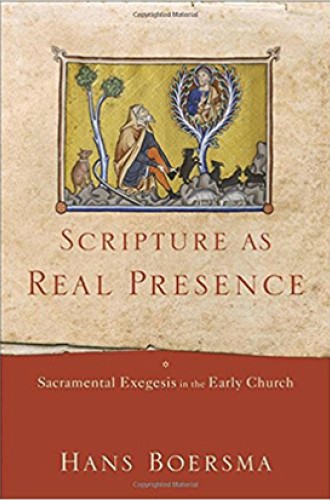Reading the Bible with a sacramental sensibility
Hans Boersma sees scripture as more open to imaginative reading than our modern methods permit. The key is faith in Christ.
Hans Boersma, who teaches theology at Regent College in Vancouver, has written a compelling book on patristic interpretation of scripture that proceeds from a “sacramental sensibility.” He provides a rich inventory of examples of patristic exegesis, notably Origen and Augustine, and advocates for the recovery of such a reading—one that with great figurative imagination finds the Old Testament fully occupied by the mystery of Christ. Boersma’s approach to scripture, which he identifies as “Christian Platonism,” contrasts starkly with the thin, rationalistic historical-critical approaches of conventional modernity.
The book contains nine studies of specific texts and the ways they were read by the early church fathers. In each case, Boersma brings to the text an immense amount of discerning scholarship from the vast patristic corpus. The sum of his argument is that all scripture is richer, more complex, more pluralistic, and more open to imaginative reading than our modern methods have permitted. The key to that rich, complex, pluralistic, openness is faith in Christ, for it is Christ who occupies every part of scripture as “real presence.”
Read our latest issue or browse back issues.
Several of Boersma’s examples are worth lingering over. Discussing the “visitation” to Abraham and Sarah at Mamre (Genesis 18), Boersma uses the rubric “hospitable reading.” He shows how Origen read the text as an embodiment of divine “condescension” in order to accommodate human reality. He then contrasts Origen’s perspective with that of John Chrysostom, who finds in the text hospitality as a “moral virtue.” Thus, the text points to a generosity not only of divine condescension but also of human practice. But in contrasting Origen’s Alexandrian reading with Chrysostom’s Antiochian perspective, Boersma claims that the latter is “more horizontal” in its import. This theme of human moral responsibility is largely absent in the remainder of Boersma’s book (except when it appears in his final study, on the Beatitudes).
Another case study focuses on the Joshua narrative, a book of violence. Origen asserts that the mystery of Christ “already lies embedded” in the text. As a result, Boersma claims that Origen is “almost oblivious to what the original author may have meant with the text of the book of Joshua.” Such a “disposal” of the text by a church father may seem strange to us, but given the embarrassing violence in the Joshua story we can easily find parallel contemporary disposals, as in Douglas Earl’s The Joshua Delusion? (2010).
In the case of Proverbs 8, Boersma shows how the church fathers struggled mightily with the actual words of the text in which “wisdom” (the divine logos) is said to be “created, established, begat.” Each of these terms suggests that the logos was “not from the beginning,” a thought that was anathema to the high Christology of the fathers and seemed to serve Arian propensities. Boersma allows that the interpretive struggle was a “winding, perhaps even tortuous path” before a claim for Christ was made from the text.
I must confess that I approached this book with suspicion. I am generally leery about scripture being passed through the lens of the church fathers and the prism of sacramental theology, because this process can lead to a reading so remote from any responsible critical understanding that it lacks persuasiveness. However, when I arrived at Boersma’s chapter on “prophetic reading,” which focuses on the church’s reading of the suffering servant of Isaiah 53, my suspicions were allayed. Boersma observes that the starting point for reading the suffering servant as Christ is not exegetical theory or a result of critical speculation but rather “the conviction that Jesus Christ is the sacramental reality already present within the prophetic descriptions of Isaiah’s suffering servant.” In other words, the beginning point is faith.
Boersma appeals to Gadamer’s formulation of the historical functioning of a text. Gadamer’s approach is to align interpretation with “the horizon of the interpreted object,” which Boersma defines in this case as Christ. Boersma’s rather folksy example is the readiness of his conservative students to read Christ into Isaiah 40:1–2 (which is never quoted in the New Testament) because they are shaped by Handel’s Messiah. This is, says Boersma, an example of Gadamer’s historical functioning that generates a reading unrestrained by “criticism.” Boersma concludes that “familiarity does not breed contempt; it breeds insight and understanding.” Such familiarity, he recognizes, operates most powerfully in the liturgy of the church that teaches us to read knowingly.
Throughout the book, Boersma acknowledges how odd and difficult this approach is to modern readers. He even reports on his own slow conversion to this perspective. In the end, he claims that what is important is not the specific exegesis of any particular text by any particular church father but rather the sacramental sensibility that funded the fathers’ shared approach. This sacramental sensibility to the real presence of Christ in the text does not require—or even permit—a slavish following of the fathers.
Boersma resists the assumption that the movement of modern critical sensibility is irreversible because he does not believe that knowledge is progressive and evolutionary. As a result, the recovery of sacramental sensibility is “possible and necessary” because it is “to put it bluntly—true.”
I came away from the book aware that I affirm, with Boersma, the thickness of scripture beyond our thin reductive criticism. I am not fully convinced, but now I understand in part. It is likely that thin critical thinking by progressives and defensive rationalism by conservatives have left us without imagination or courage for the place where God has put us.
Sacramental sensibility, as exposited by Boersma, leaves us with many difficult unresolved questions. Boersma shows, nevertheless, that this ancient trajectory is worth our effort. Historical criticism has resulted from our embarrassment about the text; sacramental sensibility may be a way to turn from embarrassment to embrace of the text that has funded courage and imagination for those long before us, and perhaps for us now.







